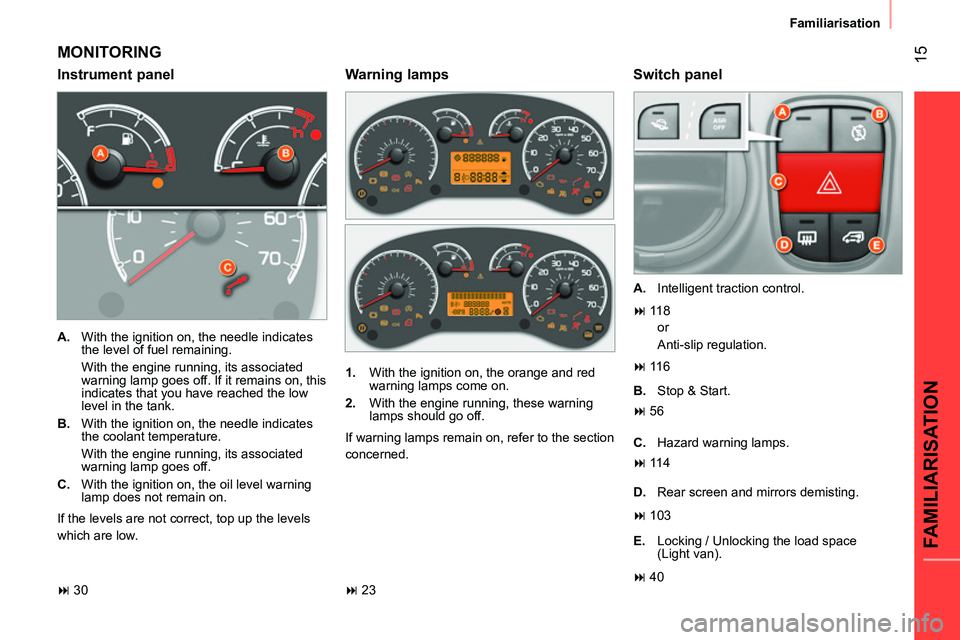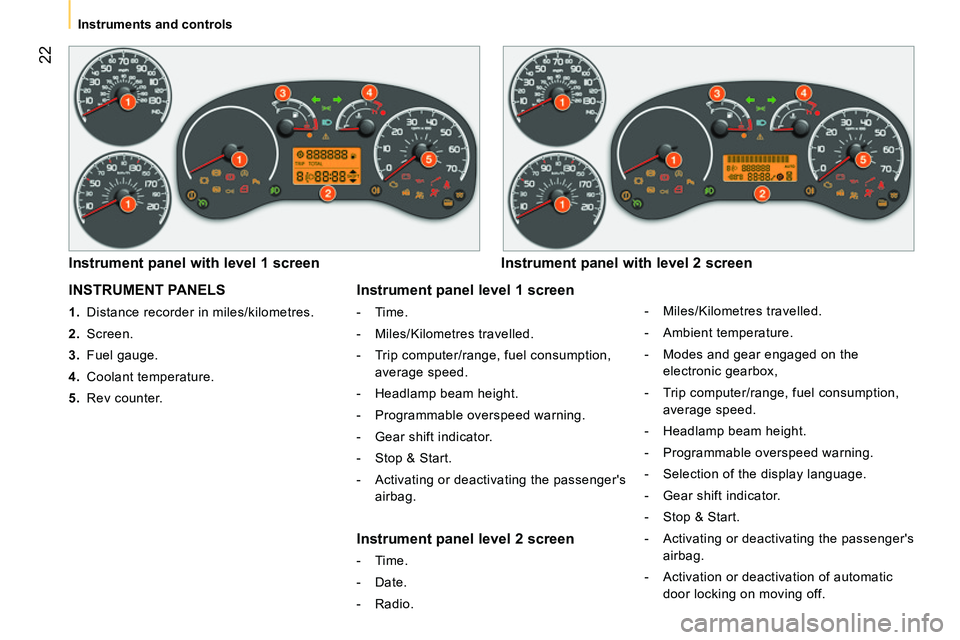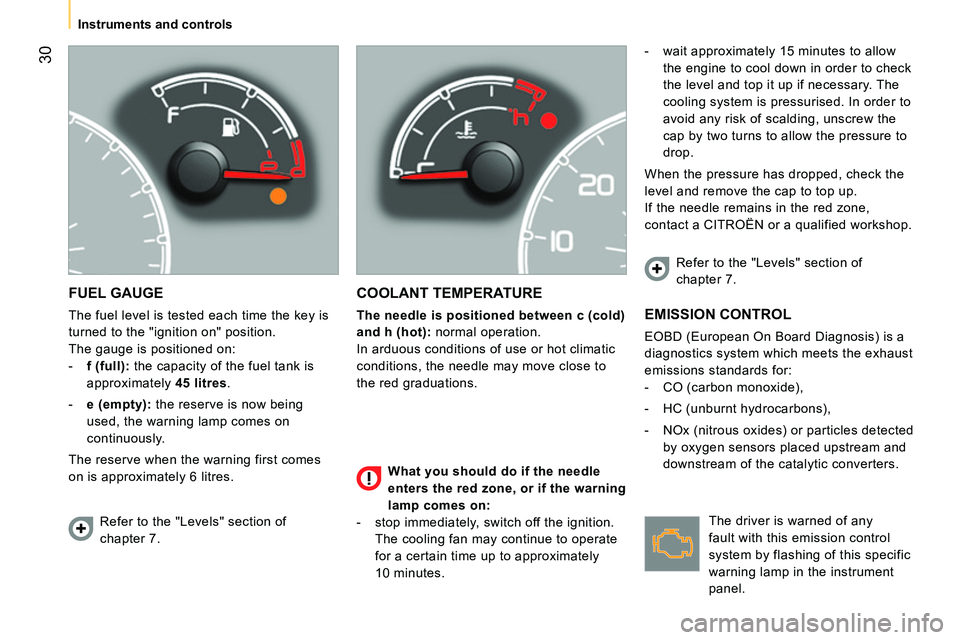coolant CITROEN NEMO 2014 Handbook (in English)
[x] Cancel search | Manufacturer: CITROEN, Model Year: 2014, Model line: NEMO, Model: CITROEN NEMO 2014Pages: 192, PDF Size: 10.74 MB
Page 4 of 192

2
Contents
2. TECHNICAL DATA 60-684. EASE OF USE and
COMFORT 96-113
Dimensions 60
Engines 66
Weights 68 Exterior 4
Access 5
Instruments and
controls 6
Load space 8
Rear fi ttings 10
Sitting
comfortably 11
Seeing clearly 13
Ventilation 14
Monitoring 15
Passenger
safety 16
Driving safely 17
Starting 19
Eco-driving 20
FAMILIARISATION
4-21
Front seats 96
Retractable
passenger seat 98
Rear bench
seat 99
De-icing and
demisting 103
Air conditioning 104
Front fi ttings 107
Load space
fi ttings 109
Rear layout 111
Interior lighting -
courtesy lamps 113
3. TECHNOLOGY
on BOARD 69-95
Trip computer/
Confi guration -
Personalisation
of the vehicle 69
Rear parking
sensors 73
Audio equipment 74
Steering mounted
controls 75
Bluetooth hands-free
system 78
1. READY TO GO
22-59
Instrument
panels 22
Warning lamps 23
Fuel gauge 30
Coolant
temperature 30
Indicator 31
Remote control 32
Key 34
Alarm 36
Opening 37
Closing 40
Lighting stalk 42
Wipers stalk 44
Cruise control 45
Fixed speed
limiter 46
Mirrors 47
Electric windows 48
Steering wheel
adjustment 49
Manual gearbox 49
Electronic
gearbox 51
Hill start assist 55
Stop & Start 56
Page 17 of 192

15
FAMILIARISATION
Familiarisation
MONITORING
Instrument panel
Switch panel
A.
With the ignition on, the needle indicates
the level of fuel remaining.
With the engine running, its associated
warning lamp goes off. If it remains on, this
indicates that you have reached the low
level in the tank.
B.
With the ignition on, the needle indicates
the coolant temperature.
With the engine running, its associated
warning lamp goes off.
C.
With the ignition on, the oil level warning
lamp does not remain on.
If the levels are not correct, top up the levels
which are low.
A.
Intelligent traction control.
1.
With the ignition on, the orange and red
warning lamps come on.
2.
With the engine running, these warning
lamps should go off.
If warning lamps remain on, refer to the section
concerned.
Warning lamps
or
Anti-slip regulation.
B.
Stop & Start.
C.
Hazard warning lamps.
D.
Rear screen and mirrors demisting.
E.
Locking / Unlocking the load space
(Light van).
30 23 11 8
11 6
56
11 4
103
40
Page 24 of 192

22
Instruments and controls
INSTRUMENT PANELS
1.
Distance recorder in miles/kilometres.
2.
Screen.
3.
Fuel gauge.
4.
Coolant temperature.
5.
Rev counter.
Instrument panel with level 1 screen
Instrument panel with level 2 screen
Instrument panel level 1 screen
- Time.
- Miles/Kilometres travelled.
- Trip computer/range, fuel consumption,
average speed.
- Headlamp beam height.
- Programmable overspeed warning.
- Gear shift indicator.
- Stop & Start.
- Activating or deactivating the passenger's
airbag.
Instrument panel level 2 screen
- Time.
- Date.
- Radio.
- Miles/Kilometres travelled.
- Ambient temperature.
- Modes and gear engaged on the
electronic gearbox,
- Trip computer/range, fuel consumption,
average speed.
- Headlamp beam height.
- Programmable overspeed warning.
- Selection of the display language.
- Gear shift indicator.
- Stop & Start.
- Activating or deactivating the passenger's
airbag.
- Activation or deactivation of automatic
door locking on moving off.
Page 25 of 192

23
1
READY TO GO
Instruments and controls
WARNING LAMPS
Each time the engine is started: a series of warning lamps comes on applying a self-checking test. They go off almost immediately. When
the engine is running: the warning lamp becomes a warning sign if it remains on continuously or flashes. This initial warning may be
accompanied by an audible signal and a message in the screen. "Do not ignore these warnings."
Warning lamp
is
indicates
Solution - action
Service on temporarily. minor faults. Contact a CITROËN dealer or a qualified
workshop.
continuously on,
accompanied by a
message in the screen. major faults. Make a note of the warning message and contact
a CITROËN dealer or qualifi ed workshop.
Parking brake
Brake fluid level on.
that the parking brake is applied or
has not been released correctly. Releasing the parking brake switches off the
warning lamp.
on. that the fluid level is too
low. Top up using a fluid recommended by CITROËN
dealers.
continuously on, even
though the level is
correct.
Stop as soon as it is safe to do so, park,
switch off the ignition and contact a
CITROËN dealer or qualified workshop.
Low engine oil level on. that the level of oil in the
engine is too low. Check the engine oil level and contact a
CITROËN dealer or a qualified workshop.
continuously on, even
though the level is correct.
Stop as soon as it is safe to do so, park,
switch off the ignition and contact a
CITROËN dealer or a qualified workshop.
Coolant temperature on with the needle in
the red zone. an abnormal increase. Park and switch off the ignition, allow the system
to cool. Visually check the level.
on H in the red zone. an abnormal increase in
the coolant temperature. Refer to the "Levels" section of chapter 7.
Contact a CITROËN dealer or a qualified
workshop.
Page 32 of 192

30
Instruments and controls
FUEL GAUGE
The fuel level is tested each time the key is
turned to the "ignition on" position.
The gauge is positioned on:
- f
(full):
the capacity of the fuel tank is
approximately 45 litres
.
- e
(empty):
the reserve is now being
used, the warning lamp comes on
continuously.
The reserve when the warning first comes
on is approximately 6 litres.
COOLANT TEMPERATURE
The needle is positioned between
c
(cold)
and
h
(hot):
normal operation.
In arduous conditions of use or hot climatic
conditions, the needle may move close to
the red graduations.
- wait approximately 15 minutes to allow
the engine to cool down in order to check
the level and top it up if necessary. The
cooling system is pressurised. In order to
avoid any risk of scalding, unscrew the
cap by two turns to allow the pressure to
drop.
When the pressure has dropped, check the
level and remove the cap to top up.
If the needle remains in the red zone,
contact a CITROËN or a qualified workshop. EMISSION CONTROL
EOBD (European On Board Diagnosis) is a
diagnostics system which meets the exhaust
emissions standards for:
- CO (carbon monoxide),
- HC (unburnt hydrocarbons),
- NOx (nitrous oxides) or particles detected
by oxygen sensors placed upstream and
downstream of the catalytic converters.
Refer to the "Levels" section of
chapter 7. Refer to the "Levels" section of
chapter 7.
The driver is warned of any
fault with this emission control
system by flashing of this specific
warning lamp in the instrument
panel.
What you should do if the needle
enters the red zone, or if the warning
lamp comes on:
- stop immediately, switch off the ignition.
The cooling fan may continue to operate
for a certain time up to approximately
10 minutes.
Page 139 of 192

137
6
ACCESSORIES
Towing a trailer
TOWING A TRAILER, CARAVAN, ETC...
Driving advice
As the fan is electrically controlled, its
cooling capacity is not dependent on the
engine speed.
On the contrary, use a high gear to lower the
engine speed and reduce your speed. In all cases, pay attention to the coolant
temperature. A towed vehicle must free wheel: gearbox in
neutral.
Cooling:
towing a trailer on a slope
increases the coolant temperature.
Page 140 of 192

138
Towing a trailer
In certain cases of particularly arduous
use (towing the maximum load up a steep
slope in high temperatures), the engine
automatically limits its power. In this case,
automatic cutting off of the air conditioning
allows the engine power to be saved.
If the coolant temperature
warning lamp comes on, stop the
vehicle and switch off the engine
as soon as possible.
See the "Levels" section of chapter 7.
Tyres:
check the tyre pressures of the
towing vehicle (see the "Identification
markings" section of chapter 7) and of
the trailer, observing the recommended
pressures.
Brakes:
towing increases the braking
distance. Drive at a moderate speed,
change down early and brake gradually.
Side wind:
sensitivity to side wind is
increased. Drive smoothly and at a
moderate speed.
ABS:
the system only controls the vehicle,
not the trailer.
Rear parking sensors:
the sensors
will be deactivated automatically
when an genuine CITROËN towbar is used
(see the "Rear parking sensors" section of
chapter 3).
Towbar
We recommend the use of genuine
CITROËN towbars and their harnesses,
which have been tested and approved from
the design stage of your vehicle, and that
the fitting of this equipment is entrusted to a
CITROËN dealer or a qualified workshop.
If this equipment is not fitted by a CITROËN
dealer, it is essential that it is fitted using
the electrical pre-equipment located at
the rear of the vehicle and following the
manufacturer's instructions.
The operation of the rear parking sensors is
deactivated automatically when the trailer
cable connector is inserted in the towbar
socket.
When the trailer cable is removed, the rear
parking sensors are re-activated.
Distribution of loads
Distribute the load in the trailer so that the
heaviest objects are as close as possible
to the axle and the nose weight is close to
the maximum authorised without, however,
exceeding it. The air density decreases with
altitude, so reducing the performance of
the engine. The maximum towed load must
be reduced by 10 % for each 1 000 metres
of altitude. Refer to the "Technical data"
chapter for details of the weights and
towed loads applicable to your vehicle
and also to the administrative documents
(V5 registration document, ...).
Page 169 of 192

167
7
QUICK HELP
Under the bonnet
Diesel engine
UNDER THE BONNET
1. Screenwash reservoir.
2. Fusebox.
3. Engine coolant header tank.
4. Brake and clutch fluid reservoir.
5. Air filter.
6. Dipstick.
7. Engine oil filler cap.
8. Power steering fluid reservoir.
Page 170 of 192

168
Under the bonnet
Petrol engine
UNDER THE BONNET
1. Screenwash reservoir.
2. Fusebox.
3. Engine coolant header tank.
4. Brake and clutch fluid reservoir.
5. Air filter.
6. Dipstick.
7. Engine oil filler cap.
8. Power steering fluid reservoir.
Page 172 of 192

170
Levels
Engine coolant level
Only use the fl uid recommended by the
manufacturer. Otherwise, you risk seriously
damaging your engine. When the engine
is warm, the temperature of the coolant is
controlled by the engine cooling fan. As this fan
can operate with the ignition key removed and
because the cooling system is pressurised,
wait for at least one hour after the engine has
stopped before carrying out any work.
Topping up
The level must be between the MIN
and
MAX
marks on the header tank. If more than
1 litre of fluid is required to top up the level,
have the system checked by a CITROËN
dealer or a qualified workshop.
Power steering fluid level
The vehicle must be parked on level ground
with the engine cold. Unscrew the cap with
integral gauge and check the level which
must be between the MIN
and MAX
marks.
Screenwash fluid level
For optimum cleaning and to avoid freezing,
topping up or replacement of this fluid
should never be with plain water; we
recommend the use of products available
from CITROËN dealers.
Capacity of the reservoir: approximately
3 litres. Slacken the cap by two turns to release the
pressure to prevent any risk of scalding.
When the pressure has dropped, remove the
cap and top up the level with coolant.
If fluid has to be added frequently, this
indicates a fault which must be checked by a
CITROËN dealer or a qualified workshop as
soon as possible.
Used products
Avoid prolonged contact of used oil with the
skin.
Brake fluid is harmful to health and very
corrosive.
Do not dispose of used oil, brake fluid or
coolant into drains or into the ground, but
into the containers provided for this purpose
at CITROËN dealers (France) or at an
authorised waste disposal site.